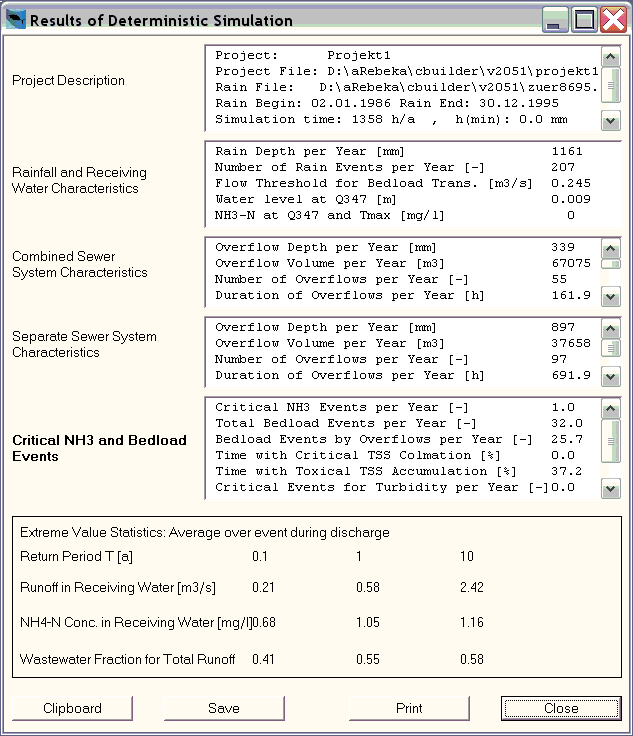Deterministic Simulation
Model Description
REBEKA2 uses a fixed catchment configuration (Rauch et al., 2002). It
consists of each a combined and a separate sewer system that both
discharge into the same river. For consideration of the upstream
dynamics in the river discharge a third natural catchment is included.
Additional discharges (e.g. from industrial sources or from an upstream
sewer system) may be included by means of an external inflow (constant
or constant during rainfall). Both urban catchments have a detention
basin installed, prior to the discharge into the receiving water.

To analyse a given situation by REBEKA2 it is therefore necessary to
simplify the existing combined and separate sewer systems and the
natural catchment and describe them by linear reservoirs. The most
difficult part of the simplification is the handling of multiple
overflow structures in the sewer system because REBEKA only allows for
one overflow device per sewer system. Solutions to this problem are (1)
either to make a separate analysis of the importance of each overflow
structure and choose the most important one or (2) model the sewer
system progressively from the uppermost to the lowermost overflow
structure taking the outflow from the first subsystem as constant
inflow to the second subsystem etc.
Rainfall data
For simulating the systems dynamics, long time series of precipitation
data are required as model input. In order to simplify the use of the
software, REBEKA offers a choice of five rain series. The series have
been selected to represent the main hydrological characteristics of
Swiss regions. All five series cover the same time period from 1986 to
1995. User specific rain data (in KMD-format) of arbitrary length can
be read. Time resolution must be 10 min. To investigate seasonal
effects it is possible to choose only specific months of the year
within the 10-year rainfall data.
Runoff simulation
The generation of stormwater is calculated by considering the initial
losses and only that part of the catchment area that actually produces
runoff. Surface flow is computed by means of the linear reservoir model.
These models have been used for all three types of catchments (see
figure). The effluent from both the combined and the separate system is
subsequently discharged via a CSO (or via a retention basin
respectively) into the receiving water. As superposition and
instantaneous mixing of the three discharges is assumed, hydrodynamic
effects are conveniently neglected. The type of CSO and retention basin
can be chosen as on- or off-line.
Water quality simulation
Ammonia concentration is computed by means of a simple mixing model,
where constant concentrations are assumed in the base flow, the
stormwater and the wastewater.
Total suspended solids (TSS) load is calculated by a stochastic
approach (Rossi et al., 2004, Rossi et al. 2005). The model predicts
the probability of TSS loads arising from CSOs in combined sewer
systems as well as from stormwater in separate sewer systems, and the
amount of TSS that is retained in treatment devices on both sewer
systems.
Results of deterministic simulation
This screenshot from the program shows an example of the output from
the deterministic simulation.

If the user needs more detailed results, he can analyse the file
*_det.csv and *_step.csv which are generated during the simulation.
*_det.csv contains a summary of the results per rainfall event. Each
line represents the results for an event.
*_step.csv contains results for each time step (10min) of the
simulation. Each line represents a time step. By default, only the
first 100 events are output.
REFERENCES
Rauch W., Krejci V. and Gujer
W. (2002). REBEKA - a software tool for planning urban drainage on the
basis of predicted impacts on receiving water. Urban Water, 4: 355-361.
Rossi L., Kreikenbaum S.,
Gujer W., Fankhauser R. (2004). Modélisation des matières en suspension
(MES) dans les rejets urbains en temps de pluie. Gas, Wasser,
Abwasser
10(2004):753-761.
Rossi L., Krejci V., Rauch W.,
Kreikenbaum S., Fankhauser R., and Gujer W. (2005). Stochastic modeling
of total suspended solids (TSS) in urban areas during rain events.
Water Research 39(17): 4188-4196.

